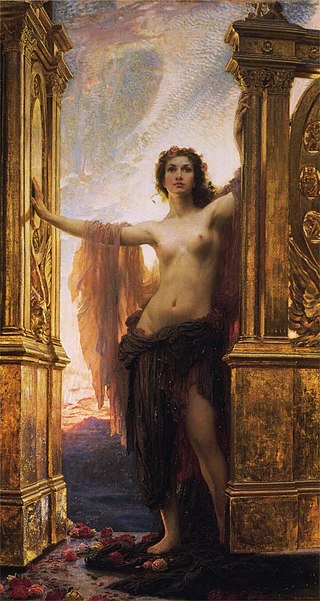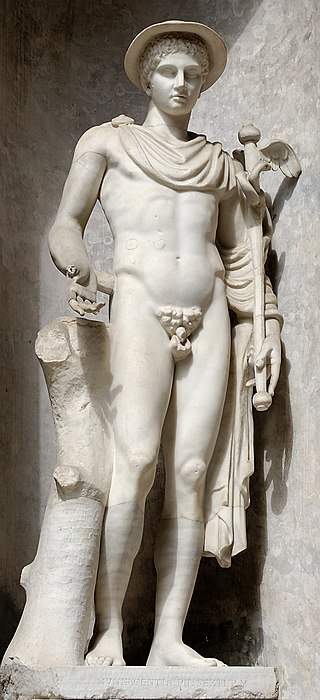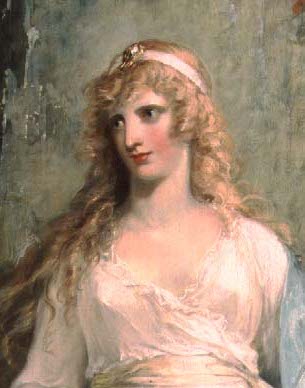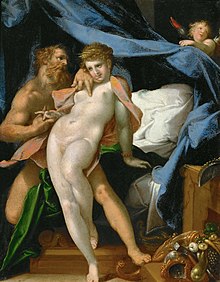
In ancient Greek mythology and religion, Eos is the goddess and personification of the dawn, who rose each morning from her home at the edge of the river Oceanus to deliver light and disperse the night. In Greek tradition and poetry, she is characterized as a goddess with a great sexual appetite, who took numerous human lovers for her own satisfaction and bore them several children. Like her Roman counterpart Aurora and Rigvedic Ushas, Eos continues the name of an earlier Indo-European dawn goddess, Hausos. Eos, or her earlier Proto-Indo-European (PIE) ancestor, also shares several elements with the love goddess Aphrodite, perhaps signifying Eos's influence on her or otherwise a common origin for the two goddesses. In surviving tradition, Aphrodite is the culprit behind Eos' numerous love affairs, having cursed the goddess with insatiable lust for mortal men.

Hermes is an Olympian deity in ancient Greek religion and mythology considered the herald of the gods. He is also widely considered the protector of human heralds, travelers, thieves, merchants, and orators. He is able to move quickly and freely between the worlds of the mortal and the divine aided by his winged sandals. Hermes plays the role of the psychopomp or "soul guide"—a conductor of souls into the afterlife.

In ancient Greek mythology and religion, Leto is a goddess and the mother of Apollo and Artemis. She is the daughter of the Titans Coeus and Phoebe, and the sister of Asteria.

In Greek mythology, Styx, also called the River Styx, is a goddess and one of the rivers of the Greek Underworld. Her parents were the Titans Oceanus and Tethys, and she was the wife of the Titan Pallas and the mother of Zelus, Nike, Kratos, and Bia. She sided with Zeus in his war against the Titans, and because of this, to honor her, Zeus decreed that the solemn oaths of the gods be sworn by the water of Styx.

In ancient Greek religion and mythology, Hestia is the virgin goddess of the hearth and the home. In myth, she is the firstborn child of the Titans Cronus and Rhea, and one of the Twelve Olympians.

Rhea or Rheia is a mother goddess in ancient Greek religion and mythology, the Titan daughter of the earth goddess Gaia and the sky god Uranus, himself a son of Gaia. She is the older sister of Cronus, who was also her consort, and the mother of the five eldest Olympian gods and Hades, king of the underworld.

In Greek mythology and religion, Themis is the goddess and personification of justice, divine order, law, and custom. She is one of the twelve Titan children of Gaia and Uranus, and the second wife of Zeus. She is associated with oracles and prophecies, including the Oracle of Delphi. Her symbol is the Scales of Justice.
In Greek mythology, Arcas was a hunter who became king of Arcadia. He was remembered for having taught people the arts of weaving and baking bread and for spreading agriculture to Arcadia.
In Greek mythology, Coeus, also called Polus, was one of the Titans, one of the three groups of children born to Uranus (Sky) and Gaia (Earth).

In Greek mythology, Harmonia is the goddess of harmony and concord. Her Roman counterpart is Concordia. Her Greek opposite is Eris, whose Roman counterpart is Discordia.

In Greek mythology, Tethys was a Titan daughter of Uranus and Gaia, a sister and wife of the Titan Oceanus, and the mother of the river gods and the Oceanids. Although Tethys had no active role in Greek mythology and no established cults, she was depicted in mosaics decorating baths, pools, and triclinia in the Greek East, particularly in Antioch and its suburbs, either alone or with Oceanus.
In Greek mythology, Hyperion was one of the twelve Titan children of Gaia (Earth) and Uranus (Sky). With his sister, the Titaness Theia, Hyperion fathered Helios (Sun), Selene (Moon) and Eos (Dawn).

In Greek mythology, Calypso was a nymph who lived on the island of Ogygia, where, according to Homer's Odyssey, she detained Odysseus for seven years against his will. She promised Odysseus immortality if he would stay with her, but Odysseus preferred to return home. Eventually, after the intervention of the other gods, Calypso was forced to let Odysseus go.

In ancient Greek religion and mythology, Phoebe is one of the first generation of Titans, who were one set of sons and daughters of Uranus and Gaia, the sky and the earth. With her brother and consort Coeus she had two daughters, Leto and Asteria. She is thus the grandmother of the Olympian gods Apollo and Artemis, as well as the witchcraft goddess Hecate.

In ancient Greek religion and Greek mythology, Dione is an oracular goddess, a Titaness primarily known from Book V of Homer's Iliad, where she tends to the wounds suffered by her daughter Aphrodite. Dione is presented as either an Oceanid, daughter of Oceanus and Tethys, or the thirteenth Titan, daughter of Gaia and Uranus.
In Greek mythology, Pallas or Pallant was, according to Hesiod, the son of the Titans Crius and Eurybia, the brother of Astraeus and Perses, the husband of Styx, and the father of Zelus, Nike ("Victory"), Kratos, and Bia. Hyginus says that Pallas, whom he calls "the giant", also fathered with Styx: Scylla, Fontus ("Fountains") and Lacus ("Lakes"). Pallas was sometimes regarded as the Titan god of warcraft and of the springtime campaign season.
Greco-Roman mythology features male homosexuality in many of the constituent myths. In addition, there are instances of cross-dressing, androgyny, and other themes which are grouped under the acronym LGBTQ+.
In Greek mythology, Eleusis or Eleusinus was the eponymous hero of the town of Eleusis.

In Greek mythology, Asteria or Asterie is a daughter of the Titans Coeus (Polus) and Phoebe and the sister of Leto. According to Hesiod, by the Titan Perses she had a single child, a daughter named Hecate, the goddess of witchcraft. Other authors made Asteria the mother of the fourth Heracles and Hecate by Zeus.

In Greek mythology, Cyllene, also spelled Kyllene, is the Naiad or Oread nymph and the personification of Mount Cyllene in Arcadia, the region in Greece where the god of travelers and shepherds Hermes was born and brought up. In some versions Cyllene is said to have been Hermes' nurse while he was growing up.
















